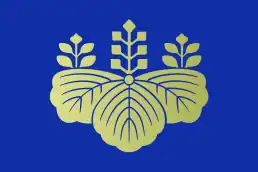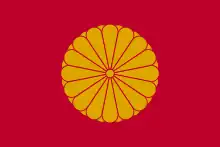| Horikawa | |
|---|---|
| Emperor of Japan | |
| Reign | January 3, 1087 – August 9, 1107 |
| Coronation | January 16, 1087 |
| Predecessor | Shirakawa |
| Successor | Toba |
| Born | August 8, 1079 |
| Died | August 9, 1107 (aged 28) |
| Burial | Nochi no Yenkyō-ji no misasagi (Kyoto) |
| Spouse |
|
| Issue Among others... |
|
| House | Yamato |
| Father | Emperor Shirakawa |
| Mother | Fujiwara no Kenshi |
Emperor Horikawa (堀河天皇, Horikawa-tennō, August 8, 1079 – August 9, 1107) was the 73rd emperor of Japan,[1] according to the traditional order of succession.[2]
Horikawa's reign spanned the years from 1087 through 1107.[3]
Biography
Before his ascension to the Chrysanthemum Throne, his personal name (imina)[4] was Taruhito-shinnō (善仁親王).[5] He was also known as Yoshihito-tennō.[6]
Horikawa was the son of Emperor Shirakawa. His mother was Fujiwara no Kenshi (藤原賢子), adopted daughter of Fujiwara Morozane (藤原師実). His wet nurse was a different Fujiwara no Kenshi (藤原兼子).
- Empress (chūgū): Imperial Princess Tokushi (篤子内親王), Emperor Go-Sanjo’s daughter
- Consort (Nyōgo): Fujiwara no Ishi (藤原苡子; 1076-1103), Fujiwara no Sanesue’s daughter
- Imperial Prince Munehito (宗仁親王) later Emperor Toba
- Lady-in-waiting (Naishi): Princess Jinshi (仁子女王; d.1126), Prince Yasusuke’s daughter
- Imperial Princess Soshi (悰子内親王, 1099–1162)
- Lady-in-waiting (Naishi): Fujiwara Muneko (藤原宗子; d.1129), Fujiwara Takamune’s daughter
- Kangyō (寛暁; 1103–1159)
- Lady-in-waiting (Naishi): Fujiwara Tokitsune’s daughter
- Imperial Prince Priest Saiun (最雲法親王; 1105–1162) head priest of Tendai sect
- Mother Unknown
- Imperial Princess Kishi (喜子内親王)
- Imperial Princess Kaishi (懐子内親王)
Events of Horikawa's life
He became Crown Prince and became emperor on the same day that his father abdicated. His reign was overshadowed by the cloistered rule of former emperor Emperor Shirakawa.
- January 3, 1087 (Ōtoku 3, 26th day of the 11th month): In the 14th year of Emperor Shirakawa-tennō 's reign (白河天皇十四年), the emperor abdicated; and the succession (‘‘senso’’) was received by his second son. Shortly thereafter, Emperor Horikawa is said to have acceded to the throne (‘‘sokui’’).[7]
His father's kampaku, Fujiwara Morozane became sesshō (regent), but Shirakawa held actual power as cloistered Emperor. Horikawa filled his reign with scholarship, poetry, and music.
When his empress-consort (kōgō) died, his son, Imperial Prince Munehito, who had become Crown Prince (and later became Emperor Toba) was taken to be raised by Horikawa's father, the retired Emperor Shirakawa.
- 1105 (Chōji 2, 6th month): A red-colored snow fell over a large area in Japan.[8]
- August 9, 1107 (Kajō 2, 19th day of the 7th month): Horikawa died at the age of 29.[9]

Horikawa died at age 29 in Kajō 2, on the 19th day of the 7th month 1107. He had reigned 20 years—seven years in the nengō Kanji, two years in Kahō, one year in the nengō Eichō, two years in Jōtoku, five years in the nengō Kōwa, two years in Chōji, and two years in the nengō Kajō.[10]
The actual site of Horikawa's grave is known.[1] This emperor is traditionally venerated at a memorial Shinto shrine (misasagi) at Kyoto.
The Imperial Household Agency designates this location as Horikawa's mausoleum. It is formally named Nochi no Yenkyō-ji no misasagi.[11]
Horikawa is buried amongst the "Seven Imperial Tombs" at Ryoan-ji in Kyoto.[12] The mound which commemorates the Emperor Horikawa today named Kinugasa-yama. The emperor's burial place would have been quite humble in the period after Horikawa died. These tombs reached their present state as a result of the 19th century restoration of imperial sepulchers (misasagi) which were ordered by Emperor Meiji.[13]
Emperor Horikawa was succeeded by his son, Munehito, who would take the name Emperor Toba.[10]
Kugyō
Kugyō (公卿) is a collective term for the very few most powerful men attached to the court of the Emperor of Japan in pre-Meiji eras. Even during those years in which the court's actual influence outside the palace walls was minimal, the hierarchic organization persisted.
In general, this elite group included only three to four men at a time. These were hereditary courtiers whose experience and background would have brought them to the pinnacle of a life's career. During Horikawa's reign, this apex of the Daijō-kan included:
Eras of Horikawa's reign
The years of Horikawa's reign are more specifically identified by more than one era name or nengō.[16]
- Ōtoku (1084–1087)
- Kanji (1087–1094)
- Kahō (1094–1096)
- Eichō (1096–1097)
- Jōtoku (1097–1099)
- Kōwa (1099–1104)
- Chōji (1104–1106)
- Kajō (1106–1108)
Empresses and consorts
- 1060–1114 Empress (chūgū): Imperial Princess Princess Tokushi (篤子内親王) – fourth daughter of Emperor Go-Sanjō, and hence his aunt
- 1076–1103 Empress (kōgō): Fujiwara no Ishi (藤原苡子)
- ????–1126 Lady-in-waiting: Minamoto ?? (源仁子) – Daughter of Prince ?? (康資王)
- ????–1129 Lady-in-waiting: Fujiwara ?? (藤原宗子), daughter of Fujiwara (藤原隆宗) – later wife of Fujiwara ?? (藤原家保)
- Daughter of Fujiwara ?? (藤原時経)
Ancestry
| Ancestors of Horikawa | |||||||||||||||||||||||||||||||||||||||||||||||||||||||||||||||||||||||||||||||||||||||||||||||||||||||||||||||||||||||||||||||||||||||||||||||||||||||||||||||||||||||||||||||||||||||||||||||||||||||||||||||||||||||||||||||||||||||||||||||||||||||||||||||||||||||||||||||||||||||||||||||||||||||||||||||||||||||||||||||||||||||||||||||||||||||||||||||||||||||||||||||||||||||||||||||||||||||||||||||||||||||||||||||||||||||||||||||||||||||||||||||||||||||||||||||||||||||||||||||||||||||||||||||||||||||||||||||||||||||||||||||||||||||||||||
|---|---|---|---|---|---|---|---|---|---|---|---|---|---|---|---|---|---|---|---|---|---|---|---|---|---|---|---|---|---|---|---|---|---|---|---|---|---|---|---|---|---|---|---|---|---|---|---|---|---|---|---|---|---|---|---|---|---|---|---|---|---|---|---|---|---|---|---|---|---|---|---|---|---|---|---|---|---|---|---|---|---|---|---|---|---|---|---|---|---|---|---|---|---|---|---|---|---|---|---|---|---|---|---|---|---|---|---|---|---|---|---|---|---|---|---|---|---|---|---|---|---|---|---|---|---|---|---|---|---|---|---|---|---|---|---|---|---|---|---|---|---|---|---|---|---|---|---|---|---|---|---|---|---|---|---|---|---|---|---|---|---|---|---|---|---|---|---|---|---|---|---|---|---|---|---|---|---|---|---|---|---|---|---|---|---|---|---|---|---|---|---|---|---|---|---|---|---|---|---|---|---|---|---|---|---|---|---|---|---|---|---|---|---|---|---|---|---|---|---|---|---|---|---|---|---|---|---|---|---|---|---|---|---|---|---|---|---|---|---|---|---|---|---|---|---|---|---|---|---|---|---|---|---|---|---|---|---|---|---|---|---|---|---|---|---|---|---|---|---|---|---|---|---|---|---|---|---|---|---|---|---|---|---|---|---|---|---|---|---|---|---|---|---|---|---|---|---|---|---|---|---|---|---|---|---|---|---|---|---|---|---|---|---|---|---|---|---|---|---|---|---|---|---|---|---|---|---|---|---|---|---|---|---|---|---|---|---|---|---|---|---|---|---|---|---|---|---|---|---|---|---|---|---|---|---|---|---|---|---|---|---|---|---|---|---|---|---|---|---|---|---|---|---|---|---|---|---|---|---|---|---|---|---|---|---|---|---|---|---|---|---|---|---|---|---|---|---|---|---|---|---|---|---|---|---|---|---|---|---|---|---|---|---|---|---|---|---|---|---|---|---|---|---|---|---|---|---|---|---|---|---|---|---|---|---|---|---|---|---|---|---|---|---|---|---|---|---|---|---|---|---|---|---|---|---|---|---|---|---|---|---|---|---|---|---|---|---|---|---|---|---|---|---|---|---|---|---|---|---|---|---|---|---|---|---|---|---|---|---|---|---|---|---|---|---|---|---|---|---|---|---|---|---|---|---|---|---|---|---|---|---|---|---|---|---|---|---|---|---|---|---|---|---|---|---|---|---|---|---|---|---|---|---|---|---|---|---|---|---|---|---|
| |||||||||||||||||||||||||||||||||||||||||||||||||||||||||||||||||||||||||||||||||||||||||||||||||||||||||||||||||||||||||||||||||||||||||||||||||||||||||||||||||||||||||||||||||||||||||||||||||||||||||||||||||||||||||||||||||||||||||||||||||||||||||||||||||||||||||||||||||||||||||||||||||||||||||||||||||||||||||||||||||||||||||||||||||||||||||||||||||||||||||||||||||||||||||||||||||||||||||||||||||||||||||||||||||||||||||||||||||||||||||||||||||||||||||||||||||||||||||||||||||||||||||||||||||||||||||||||||||||||||||||||||||||||||||||||
Notes

- 1 2 Imperial Household Agency (Kunaichō): 堀河天皇 (73)
- ↑ Ponsonby-Fane, Richard. (1959). The Imperial House of Japan, p. 78.
- ↑ Brown, Delmer et al. (1979). Gukanshō, pp. 317–320; Varley, H. Paul. (1980). Jinnō Shōtōki. p. 202; Titsingh, Isaac. (1834). Annales des empereurs du Japon, pp. 171–178., p. 171, at Google Books
- ↑ Brown, pp. 264; prior to Emperor Jomei, the personal names of the emperors were very long and people did not generally use them. The number of characters in each name diminished after Jomei's reign.
- ↑ Varley, p. 202.
- ↑ Titsingh, p. 172; Brown, p. 317.
- ↑ Titsingh, p. 172; Brown, p. 317; Varley, p. 44; a distinct act of senso is unrecognized prior to Emperor Tenji; and all sovereigns except Jitō, Yōzei, Go-Toba, and Fushimi have senso and sokui in the same year until the reign of Emperor Go-Murakami.
- ↑ Titsingh, p. 177.
- ↑ Brown, p. 319; Titsingh, p. 178.
- 1 2 Titsingh, p. 178.
- ↑ Ponsonby-Fane, p. 421.
- ↑ The "Seven Imperial Tombs" at Ryoan-ji are the burial places of Uda, Kazan, Ichijō, Go-Suzaku, Go-Reizei, Go-Sanjō, and Horikawa.
- ↑ Moscher, G. (1978). Kyoto: A Contemplative Guide, pp. 277–278.
- 1 2 3 4 5 6 Brown, p. 318.
- ↑ Titsingh, p. 176.
- ↑ Titsingh, p. 171-178; Brown, p. 319.
- ↑ "Genealogy". Reichsarchiv (in Japanese). Retrieved 27 June 2018.
References
- Brown, Delmer M. and Ichirō Ishida, eds. (1979). Gukanshō: The Future and the Past. Berkeley: University of California Press. ISBN 978-0-520-03460-0; OCLC 251325323
- Moscher, Gouverneur. (1978). Kyoto: A Contemplative Guide. ISBN 9780804812948; OCLC 4589403
- Ponsonby-Fane, Richard Arthur Brabazon. (1959). The Imperial House of Japan. Kyoto: Ponsonby Memorial Society. OCLC 194887
- Titsingh, Isaac. (1834). Nihon Odai Ichiran; ou, Annales des empereurs du Japon. Paris: Royal Asiatic Society, Oriental Translation Fund of Great Britain and Ireland. OCLC 5850691
- Varley, H. Paul. (1980). Jinnō Shōtōki: A Chronicle of Gods and Sovereigns. New York: Columbia University Press. ISBN 978-0-231-04940-5; OCLC 59145842
See also
| Regnal titles | ||
|---|---|---|
| Preceded by Emperor Shirakawa |
Emperor of Japan: Horikawa 1087–1107 |
Succeeded by Emperor Toba |
